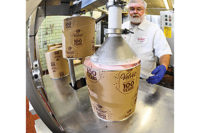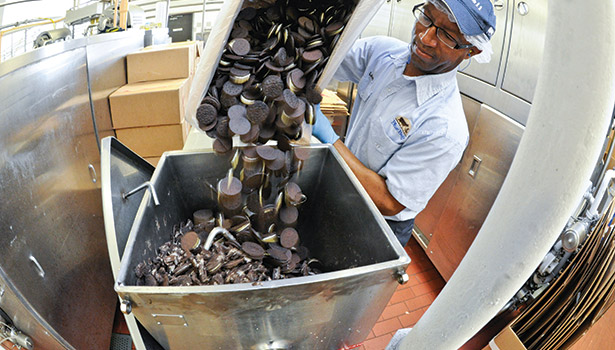Inside the ice cream plant: Blue Bell has big ideas

Cones are stacked in novelty filler. This facility makes packaged ice cream and some ice cream novelties. Other novelties are made in Blue Bell’s original creamery in downtown Brenham.

In Blue Bell’s research and development lab, R&D Food Technologist Amy Grobelny (from left), Research & Development Manager Christy Moran and Research & Development Director Brenda Valera examine a carton of ice cream.

Cookies go into a hopper to be ground into inclusions.

In the Brenham, Texas, creamery, Blue Bell fills pints, quarts, half gallons and 3-gallon containers. The company also makes novelties.

Vice President of Operations Greg Bridges said the company sends “a pretty good contingent” of employees to the International Dairy Show. “It’s a good place to see a lot of exhibitors.”

Blue Bell receives milk from dairy farmers in a 200-mile radius from Brenham, Texas. The creamery can receive a tanker and clean a tanker at the same time. A railroad siding allows for the delivery of some commodities by rail






Once an ice cream maker has learned how to make the Big Three (vanilla, chocolate and strawberry) what’s next? Where does a dairy processor go from there?
Blue Bell Creameries of Brenham, Texas, has no shortage of ideas. Every year it considers roughly 300 new flavor concepts. Through a rigorous evaluation process, the company whittles those ideas down to five or six. It is serious about finding flavors that resonate with consumers and translating those flavors into ice cream.
Offering a steady line-up of new products is important for the dairy’s customers. Supermarket chains depend upon new products to keep shoppers coming back. And because Blue Bell competes with store brands, it is vital that the ice cream maker deliver flavors that are unique and not available from other sources.
While any employee is encouraged to submit flavor ideas, Blue Bell has a structured system. Four teams, whose members are drawn from research and development, operations, sales and administration, submit ideas based on what they see happening in the food world at large, by monitoring competitors’ products and from conversations with customers.
A full-time R&D team
When Dairy Foods visited Blue Bell’s research and development laboratory in November, Director Brenda Valera, Manager Christy Moran and Associate Amy Grobelny were working on flavors for a 2016 introduction. Valera pointed to a wall of cartons that documents the company’s flavors. Some ice creams were developed for regional markets. For example, when Blue Bell entered the Denver market in 2011, it launched Rocky Mountain Road (dark chocolate ice cream with dark chocolate-coated peanuts, milk chocolate-coated pecans, white chocolate-coated almonds, roasted walnuts and a marshmallow sauce swirl). The flavor was so popular that it later was made available to the company’s full distribution.
The lab includes a stove, microwave oven, refrigerator and a pantry stocked with flavors and inclusions. Valera and her associates concoct flavor combinations using the bakery items and candy inclusions made on site. Blue Bell makes its own peppermint barks and pans chocolates, for example.
A company tasting team (consisting of six groups, each with five tasters) comes to the lab every month to taste ice creams in development. Moran gives each member a scorecard and samples to taste. The evaluation could be to judge characteristics like flavor, body and texture, meltdown, color and appearance. Or it could be to taste a substitute ingredient that’s under consideration. Teams in the company’s branch offices taste competitors’ products and submit their notes to the home office. The R&D department shares pictures from carton cuttings so everyone in the company can see what the distribution of inclusions and ribbons in the ice cream should look like.
The creamery is instrumental in new flavor development. It makes small batches of ice creams to determine how the flavors respond and react in production runs. “We want to know what R&D is looking for. Do you want inclusion to soften up or stay firm?” said Dave Hellmann, a regional planner.
At this stage, operations will tweak the recipes so they perform as expected and can in fact be manufactured consistently. Then they release the recipe to the company’s other creameries in Broken Arrow, Okla., and Sylacauga, Ala. (Frozen novelties are made in Blue Bell’s original 1930s-vintage building in downtown Brenham.) A team from Brenham meets with its counterparts in the other creameries to go over how to make the new flavors, Hellmann said. “We want to get everyone on the same page,” he added.
Supply chain management is important, Hellmann said, because ingredients, packaging and other items have to get there ahead of time. Also, the cold storage capabilities of all the plants have to be managed. As in many dairy plants, production is capable of making more product than the warehouse is able to store.
Products for groceries, foodservice
Blue Bell’s business falls into four primary categories, explained Vice President of Operations Greg Bridges. These are pints, quarts, half-gallons, 3-gallons and snacks. The customers are grocery retailers and foodservice institutions. The creamery in Brenham has the capacity to produce 30 million gallons a year, more than the plants in Alabama and Oklahoma.
The growth in sales is coming from pints and half-gallons (true 64-ounce packages), as well as in snacks, many of which conform to requirements for sale in schools. Besides grocery customers, the company is picking up business in foodservice, including restaurant chains and cruise ships.
After years of producing ice cream in the original Art Deco-design creamery in downtown Brenham, Blue Bell opened a facility on the edge of town in 1972. In 1982, the company added another processing zone, known as Area 2, and in 1994 it added Area 3. Recent capital investments (dating to 2012) include robotic systems (for palletizing and storage) and a high-rise crane in the warehouse.
A work-life balance
Although some parts of the creamery run 24 hours a day, the company’s philosophy is to provide a work-life balance. For that reason, the plant shuts down in the afternoon.
Blue Bell is “family-oriented,” said Bridges, a cousin to CEO and President Paul Kruse, whose grandfather ran the company soon after its founding. The production crew is the first to arrive (at 2 a.m.) to sanitize the equipment. Production starts at 5 a.m. and runs to 4 p.m. In other areas of the creamery, the hours are 7 a.m. to 4 p.m.
The milk supply comes from members of the Dairy Farmers of America cooperative within a 200-mile radius of Brenham. Receiving begins at 5 a.m. and occurs throughout the day. There is not a lot of waiting time for the drivers, and they appreciate that, Hellmann said. The creamery has two receiving bays. While one tanker is unloading, another can be cleaned and sent back on the road. At a separate three-stall cream bay, pasteurized milk is loaded into tankers for delivery to the novelty plant in town. Sweeteners and corn syrups arrive here, too. There is a railroad siding on the grounds. So, depending on transportation costs, sweeteners also can arrive by train.
A tourist attraction
Packaged ice cream and five types of ice cream sandwiches are made in the three production areas. A viewing gallery on the second floor allows visitors to watch the process. Blue Bell, which owns about a 60% share of market in Texas, is a top tourist attraction in the state. More than 200,000 visitors tour the creamery every year.
On the day of Dairy Foods’ visit, the packaging room was producing a variety of flavors and formats. One freezer was filling pints of Red Velvet Cake ice cream, which were hand-packed into cartons of 10 packages. Another line was filling sundae cups, which are sold to schools under Blue Bell’s Smart Snack program. Elsewhere on the floor, operators were filling 3-gallon tubs (for foodservice customers) with strawberry ice cream.
The creamery will never be fully automated, Bridges said. “We’ll add automation where it makes sense.”
He pointed out that there is a quality-control aspect to not automating every task. When a line employee is operating a freezer, he or she is looking at fill levels, the packaging and code dates. The line supervisor is also making checks. He or she can lift a package and know if it is too heavy, for example. Bridges called these quality control checks “real simple things” that can easily be achieved by human intelligence rather than machine intelligence.
The company is fond of saying, “We eat all we can and sell the rest.” Everything produced in Brenham and in the other creameries is a Blue Bell brand. It does not co-manufacture for other ice cream companies.
“We make a good product and we don’t make it for anyone else,” Bridges said.
However, when an explosion closed the plant of a nearby rival, Blue Bell pitched in. The rival’s employees made its novelties in the Brenham creamery.
“That’s the good thing about the dairy industry, we help each other out,” Bridges said.
After filling, packages travel through detection equipment and then move by conveyor to the hardening room where the ice cream is flash-frozen to a 0 F core. Ice cream then moves to the palletizer room. The smaller formats are palletized by hand. A new robotic system handles the larger and heavier 3-gallon tubs.
In the cold storage warehouse, Blue Bell is assembling a robotic sorter and picker. This new investment allows for better inventory management and for more efficient storage of pallets. The robot is programmed to pick the correct package and build pallets. It can build 2,400 pallets a day. The pallets are labeled and entered into inventory.
Trucks back into the five load-out bays at the creamery. The trailers are cooled to the proper temperature before being loaded. If the temperature inside a trailer is too warm, it can ruin ice cream pretty quickly, said Warehousing/Distribution Operations Manager Riley McManus.
Managing allergens
Blue Bell isolates allergens (including tree nuts, soy and wheat) in the warehouse and on the production floor. It isn’t easy to make ice cream when there are a number of flavors and a number of allergens involved.
“Scheduling production around allergens is always a challenge,” Hellmann said. Production of ice cream containing allergens is scheduled for the beginning and the end of the day. Certain flavors are made on dedicated lines.
Operators pay attention to details such as putting the correct flavors in the flavor tanks and using the correct carton because packaging can look similar. Tapes used to seal cartons are color-coded so allergen-containing products can be identified at a glance. Each color corresponds to an allergen.
Good food manufacturers can make great food all day long. But great companies need to offer great customer service. As Blue Bell picked up accounts outside of Texas, expectations of quality customer service were greater, Bridges said. So when a Florida chain opened one weekend, Blue Bell flew additional employees to the Sunshine State to service product requests common to new accounts.
IT investments
In many ways, an ice cream manufacturer is only as good as its information technology. VP of Information Technology Jim Kruse explained that Blue Bell uses IT in a variety of ways, including purchasing, tracking ingredients and supplies (like packaging), identifying re-work issues and managing inventory. Kruse and his team are developing “dashboards” so every plant manager can see operational data at a glance.
A wireless network in the creamery allows supervisors to input data on the fly. Before tablet computing, supervisors had to go back to the office to do that. Truck drivers have hand-held Motorola scanners and Zebra printers to help them manage their 1,000 routes.
IT is vital in the event of a product recall, said Kruse, who is a nephew of the CEO. With every pallet and trailer traceable by code, mock recalls are pain-free; that is, compared to the old days when records were kept by hand and managers had to sort through paper to find relevant information.
Blue Bell emphasizes food safety and employee safety. An in-house quality program is based on third-party certification standards by Silliker Laboratories Group, Chicago. Blue Bell has a prerequisites and HACCP plan that includes sanitation and environmental monitoring. Each team knows its department inside and out and is expected to follow up on identified problems to make sure they are corrected.
The federal Food and Drug Administration, the Texas Department of Health and Silliker inspect the creamery regularly. So does the military, since Blue Bell has a military contract.
“I don’t know anyone who likes an auditor coming into your plant. But if they help you, that’s OK. But you better know your plant better than anyone. You better be correcting issues before [the auditors] come here,” Bridges said.
Training
The Brenham production operation counts about 700 full-time employees (including those on the line, those in the warehouse and those driving trucks). With a workforce that large, training and skill development is important. The company partners with a local community college that offers training in welding, food safety and IT. Ice cream plant employees take classes at the college to improve their skills and, consequently, their earnings.
Equipment operators are cross-trained on all the equipment, although certain operators like to work only on specific lines. A career path for a college graduate might begin on the production line, learning how to run a freezer and then the entire production process.
“It is very much a hands-on job. The first year is strictly learning,” Hellmann said. Then the employee would transition into a supervisor trainee overseeing a specific area. The next steps are to area manager and then assistant plant superintendent.
It is important for everyone in the company to learn how departments work together. Managers’ jobs are to break down those walls between operations and sales. For example, a sales manager has to understand that it takes time to set up a line to run a new flavor. “Ice cream mix can’t appear in just 10 minutes,” said Hellmann.
To learn about new equipment and advances in processing, Blue Bell sends employees to trade shows, including the International Dairy Show. Although many suppliers do travel to Brenham, “we send a pretty good contingent [to the dairy show] because we want to support the IDFA. It’s a good place to see a lot of exhibitors,” Bridges said. He added that the company might find one or two ideas it can implement. It did see a robotic palletizer at the show.
As in any large food business, a lot of packaging moves in and out of the creamery. Blue Bell recycles as much corrugate and plastics as possible. Blue Bell is such a big consumer that it convinced its packaging supplier to move from Dallas to Brenham to make cartons and recycle corrugate.
With new markets being added and new flavors in development, Blue Bell is focused on making as much as ice cream as it can while adhering to its strict quality expectations. Except for new robotics in the warehouse, no other big capital expenditure projects are planned. The emphasis will be on increasing efficiency to meet the ever-growing sales from 23 states.
Automation can help, especially as “folks are becoming less available,” Bridge said. Still, the company’s focus is to be more efficient, not to eliminate jobs, he said. After all, those 300 new flavor concepts that Blue Bell considers every year come from people, not machines.
Photos by Vito Palmisano
At-A-Glance
Blue Bell Creameries, Brenham, Texas
Interstate Milk Shippers Plant No. 0702
Year plant built: 1972
Additions/renovations since opening: Second production area 1983, third production area 1994, cold storage 2013
Site: 45 acres
Number of production employees: 230
Products made and formats: Ice cream, frozen yogurt, no-sugar-added ice cream in half- gallons, pints, three-gallons and frozen snacks (including Smart Snacks)
Total processing capacity: 14,500 gallons per hour
Number of shifts: Two
Storage silos: 14 raw dairy silos totaling 300,000 gallons
Pasteurization type: Three high temperature/short time units capable of processing 4,000 to 5,000 gallons per hour
Number of filling lines: 25 for snacks, pints, half-gallons and three gallons
Vats and tanks:More than 50 pasteurized mix storage tanks of varying sizes; eight batch tanks for blending raw mixes, six vat tanks for processing different types of mixes and sauces, more than 70 flavoring vats
Looking for a reprint of this article?
From high-res PDFs to custom plaques, order your copy today!













